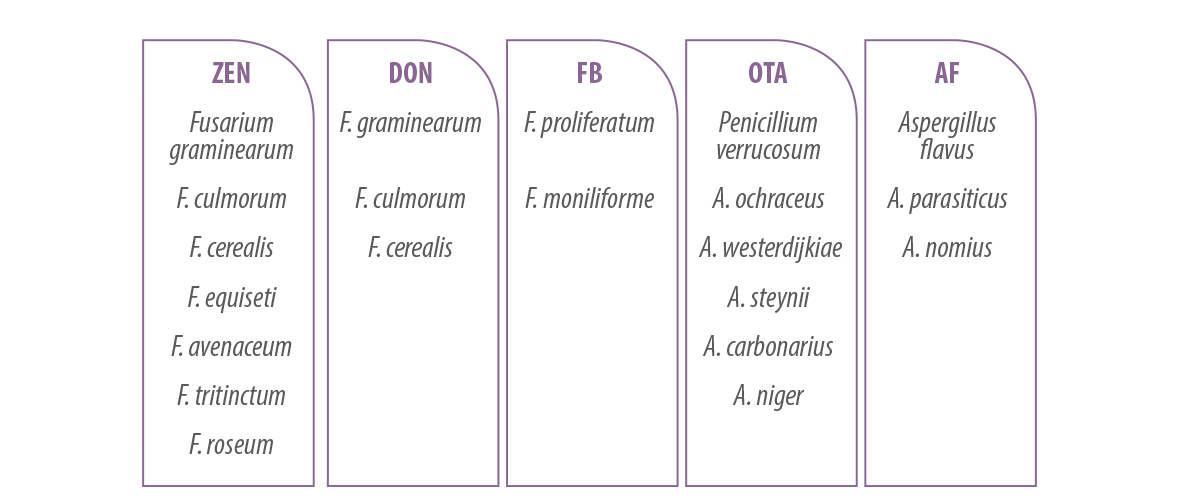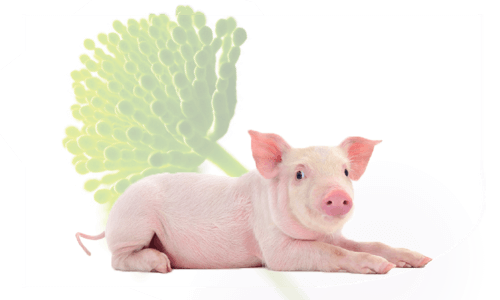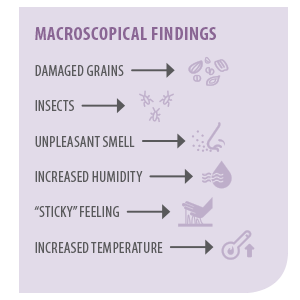
WHAT ARE MYCOTOXINS, HOW ARE THEY FORMED AND WHY IS THEIR PRESENCE IN FEED IMPORTANT?
Mycotoxins are secondary metabolites of certain fungal species that can be found in grains worldwide. They are produced before (fungi as plant pathogens) or after harvest of grains, or even during storage (fungi growing saprophytically). They are formed under favorable environmental conditions, thus under proper temperature and humidity levels.
Structure and toxic properties of mycotoxins differ and do not alter during storage or after typical feed thermal treatment (e.g. during feed pellet production).
From a general viewpoint, the significant impact of mycotoxins includes:
- ⇰ Loss of animal life after great exposure levels
- ⇰ Growth retardation
- ⇰ Impaired immunity
- ⇰ Reduced performance parameters
- ⇰ Impaired reproduction
- ⇰ Tissue damage
- ⇰ Increased veterinary care costs
The effects of mycotoxins in animals, especially in pigs, can be observed in a quite wide range, from acute cases with significant morbidity and mortality up to the more often subacute/ chronic cases with vague clinical symptoms.
Unlike microbial agents, mycotoxins do not induce any direct humoral immune response as a defense mechanism in pigs. However, they can act as deleterious agents, with variable effects on organs and tissues based on their tropism and mode of action.
Inflammation, disruption of organs’ functions, necrosis and cell apoptosis, along with several detrimental effects on the immune system (impaired innate and acquired immune responses) and cytokines expression/synthesis/ regulation (alteration of the inflammatory response) are only a small part of the extent of mycotoxins effects in swine.

WHICH ARE THE MAIN MYCOTOXINS THAT CURRENTLY AFFECT PIG HEALTH AND WHAT KIND OF RAW MATERIALS OR FEED ARE THEY MOSTLY DETECTED IN?
The most important mycotoxin producing fungi belong to the genera Aspergillus, Penicillium, Fusarium, Alternaria and Claviceps. Out of more than 300 mycotoxins, some are considered extremely significant for pig health and productivity.

Namely, aflatoxins (AF) B1, B2, G1 and G2, deoxynivalenol (DON – type B trichothecene), zearalenone (ZEN), fumonisins (FB1, FB2, FB3) and ochratoxin A (OTA) are considered significant for their devastating effects on pig production worldwide.
- 🔎 AFs are produced by Aspergillus flavus, A. parasiticus and A. nomius.
- 🔎 DON is produced mainly by Fusarium graminearum and Fusarium culmorum.
- 🔎 OTA is produced by several Aspergillus y Penicillium, tales como Penicillium verrucosum A. ochraceus, A. westerdijkiae, A. steynii, A. carbonarius and A. niger.
- 🔎 ZEN is a Fusarium toxin produced mainly by F. graminearum, F. culmorum, F. cerealis, F. equiseti and F. roseum both in the field and during storage.
- 🔎 FBs are produced mainly by Fusarium verticillioides and F. proliferatum.
 Table 1. Major swine mycotoxins and the fungi that produce them.
Table 1. Major swine mycotoxins and the fungi that produce them.
Other mycotoxins such as T-2, nivalenol, or ergot alkaloids have been suggested as somewhat significant for swine, especially in particular geographical regions where the infection of grains with the responsible fungi is more common.
Recent worldwide investigations of grains and feedstuff suggest corn as the most frequently contaminated grain. Furthermore, barley, wheat, sorghum, soya and many other could be contaminated.
It must be stated that multiple fungi can produce more than one mycotoxin, while various types of grains are used for the preparation of swine feeds, and at the same time those grains could be possibly contaminated by more than one mycotoxin. Thus the occurrence of multiple mycotoxins in final pig feed is the common finding, while the detection of one mycotoxin in one type of grain or feed is the exception in the majority of cases.
In order to partially understand the complexity of the mycotoxins menace in pig feeds worldwide, we have to take into consideration that for example, several Fusarium species can produce more than one mycotoxin.
- ⇰ F. graminearum is capable of producing DON, ZEN, 3- and 15-acetyl DON, nivalenol, diacetoxyscirpenol.
- ⇰ On the other hand, one mycotoxin could be produced by several Fusarium. Therefore, ZEN can be produced by F. graminearum, F. culmorum, F. cerealis, F. equiseti, F. avenaceum, F. tritinctum y F. roseum.

WHICH CONDITIONS CONTRIBUTE TO THE FORMATION OF THESE MYCOTOXINS?
Temperature and humidity are vital factors for fungi development and mycotoxin production.
- ⇰ F. roseum producing ZEN has an optimal temperature range of 7-15ºC and is heavily influenced by alternating high and low temperatures during maturation of grains.
- ⇰ Fusarium fungi (typical field fungi) are well developed and produce mycotoxins at high equilibrium relative humidity (>70%) or grain moisture (>22%) and temperatures varying from less than 25ºC for FB production by respective fungi, 7-21ºC for ZEN and 26-28ºC for DON production.
- ⇰ Typical storage fungi, such as Aspergillus spp. (even though A. flavus can produce AFs prior to harvest) and Penicillium spp, may produce mycotoxins even at grain moisture levels of 12–18% and temperatures varying between 10-50ºC (24-35ºC for AFs and 12-25ºC for OTA production, respectively).
- ⇰ Warm environmental temperatures, low precipitation and dry conditions support the production of AFs.
Due to the significant connection between environmental conditions and mycotoxins production, it should be mentioned that contamination type and levels in grains may vary each year.
Long time period of storage at very humid or warm conditions, occurrence of insect damage of grains, broken grains and storage in insufficiently cleaned premises (moldy silos and feed lines), can also affect mycotoxins levels in grains and feed.
Recent global climate changes and rather unexpected extreme weather conditions with quick alterations between warm and humid conditions, should be taken into account as they may assist fungi growth and mycotoxin production in grains.

HOW DO THESE MYCOTOXINS ACT AT AN ORGANIC LEVEL AND WHAT ARE THE CONSEQUENCES OF THEIR INGESTION FOR THE PIG’S HEALTH?
Each of the above-mentioned mycotoxins can induce a variety of detrimental effects in several organs and tissues.
According to respective research efforts, it has been suggested that AF’s predominantly target the liver of swine (also important for their bioactivation), OTA mainly targets the kidneys and liver, ZEN has a tropism towards the genital tract, DON towards the gastrointestinal tract and liver, while FB towards the gastrointestinal tract, liver and lungs. However, this doesn’t mean that DON cannot have any effect on the genital tract, or that ZEN cannot affect the gastrointestinal tract.
Nevertheless, even though mycotoxins are presented separately, they occur simultaneously, thus a whole new chapter is open in terms of clinical approach and research regarding their interactions in various tissues and organs(synergistic, additive or antagonistic) when those mycotoxins are concurrently ingested by swine.
AFLATOXINS
AFs predominantly affect the liver (with significant carcinogenic properties) through their reactive epoxidation product, aflatoxin 8,9-epoxide, which binds either to DNA (generating guanine adducts) or proteins and induces hepatocellular damage.
- ⇰AFs also cause detrimental effects on the digestive system (anorexia, reduced weight gain), while they have been also reported to affect reproductive and immune systems.
Their immunosuppressive effect can result in greater susceptibility to bacterial, viral, fungal and parasitic infections, as well as in reduced vaccination efficacy even at subclinical level of intoxication.
- ⇰Apart from being hepatotoxic, they have, mutagenic, carcinogenic, and possibly teratogenic properties in animals. They are categorized as Class 1 human carcinogens by the International Agency for Research on Cancer (IARC).
- ⇰ AFs decrease the absorption of nutrients and reduce weight gain.
- ⇰ Chronic exposure to low doses results in jaundice (pale-yellowish appearance of liver) with hemorrhagic sites in the liver and variable levels of fibrosis and cirrhosis, diffused centrilobular necrosis and fat degeneration. Carcinomatous lesions can be seen in adult animals after long term exposure.
- ⇰ Acute aflatoxicosis has been associated to jejunum and ileum inflammation with hemorrhaging phenomena in the lumen. It can induce death after ingestion of extremely high contamination levels.
DEOXYNIVALENOL AND FUMONISINS
DON and FB induce significant alterations on the digestive tract (DON-induced vomiting and significant detrimental effects of on intestinal barrier integrity and function) and immune system of swine, while pulmonary edema can be seen in extreme FB toxicosis cases.
Disruption of intestinal barrier integrity can result in greater susceptibility to enteric infections in animals consuming contaminated diets.

DEOXYNIVALENOL
DON, also known as vomitoxin due to its emetic-inducing effects in pigs, binds at the 60S ribosomal subunit, impairing the activity of the peptidyl transferase and inhibiting protein synthesis, while at the same time can have stimulatory or suppressive effects on the immune system.
DON toxicosis usually results in growth retardation and subsequent economic losses. Another effect of DON is the reduction of voluntary feed intake that results in subsequent growth retardation and greater susceptibility to diseases.
On the other hand, direct effects include metabolic disturbances such as alterations in nutrient absorption, and cytotoxicity.
Decreased weight gain after DON contaminated feed consumption is probably related to interference with the desire to eat and intestinal motility. Neuroendocrine signaling alterations and elevations in serotonin levels seem to be the key factor on the observed growth retardation.
FUMONISIN B
The main mode of action of FBs is based on the inhibition of sphinganine N-acyltransferase (ceramide synthase) that results in disruption of the synthesis of ceramide and sphingolipid metabolism with accumulation of sphinganine and sphingosine in blood and tissues.
Alteration of sphinganine-to-sphingosine ratio (Sa/So ratio) is used as a sensitive biomarker of FBs exposure.
FBs are carcinogenic mycotoxins while the predominant FB1 corresponds to 70% of fumonisins. This mycotoxin is classified as a potential human carcinogen (class 2B) by IARC.
Acute intoxication of swine with great levels of FB is characterized by pulmonary oedema that is related to cardiovascular toxic effects of FBs.
It has been reported that ingestion of FB results in severe morphological and functional intestinal damage, which can be described as quite similar to those introduced by DON. A synergistic and additive interaction among DON and FB1 at intestinal level has been reported.
OCHRATOXIN A
OTA is a potent inhibitor of protein synthesis, considered as major nephrotoxic agent inducing porcine nephropathy (interstitial fibrosis and tubular alterations) due to binding of OTA in specific renal organic ion transporters.
It can also induce liver damage with fatty change and necrosis, as well as affecting the immune system with the suppression of lymphocyte proliferation.
- ⇰OTA has been proved to induce depressive effect on pig appetite and subsequent reduction in weight gain, as well as reduction of feed efficiency.
- ⇰ Gastric ulcers, polyuria and polydipsia due to OTA ingestion have also been reported.
ZEARALENONE
ZEN, due to its estrogenic potency, acting like the endogenous steroidal sex hormone 17-b-oestradiol and binding to oestrogenic receptors, has a tropism towards the reproductive system where it disrupts fertility and induces a hyperestrogenism syndrome with edematous swelling and reddening of vulva.
Pigs are sensitive to ZEN and it can induce:
- ⇰Prolapse of the vulva
- ⇰Ovarian follicle damage
- ⇰ Birth of splay-leg piglets and abortions
- ⇰Chronic inflammation of the genital tract, especially after ingestion of severely contaminated feed.
Furthermore, several cytotoxic, embryotoxic, genotoxic effects and other (e.g. effects on neuroendocrine regulation) have been suggested either after in vitro or in vivo research trials in swine for some of the above mentioned toxins.
LEVELS OF CONTAMINATION
According to the European Commission (EC/32/2002 amended by EC/100/2003, EC/576/2006) the maximum permitted AFB1 contamination levels of pig feed materials is 0,02ppm.
Recommended maximum contamination levels are:
- 🔎 0,9 ppm DON
- 🔎 5 ppm total FBs
- 🔎 0,05 ppm OTA (complementary and complete feedingstuffs for pigs)
- 🔎 0,1 ppm ZEN (complementary and complete feedingstuffs for gilts and newborn piglets) or 0,25 ppm ZEN (complementary and complete feedingstuffs for sows and newborn fattening pigs)

WHICH ARE THE MAIN SYMPTOMS WE CAN FIND ASSOCIATED TO THE EXPOSURE TO MYCOTOXINS IN PIGS?
Clinical diagnosis is quite difficult in the majority of chronic cases attributed to feed contaminated with mycotoxins at low level.
As a general principle, significant clinical disorders (e.g. hyperestrogenism syndrome) in specific organs that could be associated with the particular mycotoxins, in specific age groups (e.g. gilts) that is typically following an alteration in the diet (e.g. purchase of a new feed raw material, change of feed producer etc.) must include mycotoxins as high priority in the list of differential diagnosis.
However, a clinical approach must be accompanied by respective laboratory examinations in feed and biological samples (serum/tissues) for proper diagnosis.
Typical mycotoxin-induced symptoms are usually correlated with acute intoxications, while less extensive clinical symptoms are observed in chronic-subacute cases. Cases of death due to extremely high contamination levels of mycotoxins (e.g. AFs) are not frequently observed. Clinical signs that could also be attributed to other agents (e.g. infectious agents) must be differentiated from similar observed in mycotoxicosis cases.
As an example AFs- or DON- or FBs-induced reduction of growth could also be attributed to other agents. Thus careful clinical and laboratory examination is required.
On the other hand, ZEN-induced hyperestrogenism has clear effects in external genitalia that assist diagnosis.

However, when such visible effects are not extensively present (e.g. cases of sporadic pseudopregnancy or returns to estrus), other contributing factors (e.g. Porcine Reproductive and Respiratory Virus infection – PRRS) must be differentiated. Nevertheless, the veterinarian must also have in mind, that when such cases are present, there could be a mixed clinical situation of PRRS infection and ZEN toxicosis under field conditions.
Another important fact is the ability of the above-mentioned significant mycotoxins to impair immune response in many ways:
- ⇰ AFs can deregulate antigen-presenting capacity of dentritic cells, reduce synthesis of pro-inflammatory cytokines and increase anti-inflammatory ones.
- ⇰ Depending on dose, DON can act as an immunostimulatory or immunosuppressing agent. It can also induce ribotoxic stress and subsequent inflammatory response.
- ⇰FBs alter cytokine balance in pigs and influence inflammatory response, while OTA and ZEN also affect the synthesis of particular inflammatory cytokines.

WHICH ARE THE FACTORS THAT DETERMINE THE TOXICITY OF A CERTAIN MYCOTOXIN?
Several published research efforts have suggested dose and time as major factors affecting the overall toxic consequence of mycotoxins in swine.
Furthermore, concurrent pathological conditions may affect the total “outcome” (extent and severity of clinical symptoms and pathological findings) in mycotoxicosis cases.
In addition, particular age groups could be more affected than others, such as prepubertal gilts for ZEN-attributed hyperestrogenism syndrome.
DOSE-DEPENDENT TOXICITY
DON concentrations in feed between 1-8 ppm induce clinical symptoms such as partial feed refusal and growth retardation, while concentrations exceeding 10 ppm will result in total feed refusal.
On the other hand, levels exceeding 1ppm ZEN in feed can induce relative clinical signs (1-5 ppm ZEN in feed of prepubertal gilts causes vulvovaginitis).
AFs at levels exceeding 0,2 ppm in feed have been found capable of inducing measurable alterations in swine productivity, while similar levels of contamination of OTA in feed have been proven capable of inducing renal lesions after long term exposure.
FBs levels of more than 25 ppm are expected to induce significant clinical signs, however the relative alteration of their biomarker of exposure (Sa/So ratio) can be seen after ingestion of contaminated feed with 5 ppm of total FBs. Porcine pulmonary edema can be expected at FBs contamination level that exceeds 100 ppm in swine feed.

WHEN RECEIVING A BATCH OF FEED AT THE FARM, WHAT SHOULD PRODUCERS LOOK OUT FOR THAT CAN ALERT THEM OF MYCOTOXIN CONTAMINATION?
Typical macroscopical investigation at feed reception is significant.
Improper macroscopical findings such as damaged grains, insects, unpleasant smell, increased humidity and “sticky” feeling when mixing the feed, as well as increased temperature of the feed, especially in deeper layers, are facts that can be attributed to fungi development.

It must be stated that such alarming incidents do not always correlate with significant mycotoxin production, but must be taken into consideration as an indication of potential mycotoxin production, so as to prepare respective sampling and avoid introduction of suspicious feed in the farm. Under such circumstances that feed must be put “on hold” and a mycotoxin analysis must follow.
Sampling and regular screening of feed or feedstuffs is of colossal importance for the prevention of mycotoxicosis.
An ancient Greek physician, Hippocrates of Kos (460 – 377 BC) suggested that “preventing is better than treating”, therefore prevention of swine mycotoxicosis is always better than treatment, from a health, welfare and financial viewpoint.

IN THE EVENT OF A POSSIBLE MYCOTOXICOSIS IN OUR PIGS, WHICH STEPS SHOULD WE TAKE TOWARDS CONFIRMING OUR SUSPICIONS?
Always keep in mind that the first information comes from a careful clinical examination of the animals. Thus it is vital for the veterinarian to be able to acknowledge mycotoxicosis symptoms based on the causative agent. However, as previously mentioned, such symptoms may be vague or can also be attributed to other causes (e.g. reduced growth, splay leg piglets, etc.).
- ⇰At the first stage of diagnosis, the veterinarian must include mycotoxicosis in the differential diagnosis, based on clinical signs and necropsy findings.
- ⇰At the next step, connection of clinical signs with recent alterations in feed (e.g. introduction of a new feedstuff), or with further alterations of reproductive and performance parameters and absence of reaction to common antimicrobial drugs or other common therapeutic measures against infectious agents that may have been used in the past, should increase concerns over a possible mycotoxicosis case.
As an example, quite often cases that include clinical symptoms of reproductive disorders and recent feed alterations are significant candidates of a ZEN alone or in combination with DON, toxicosis.
FEED SAMPLING
Feed sampling is crucial, as it can be a significant factor for proper diagnosis, but also for false negative or false positive results.
It is important to have trained personnel responsible for representative feed sampling in order to minimize the effect of sampling error in analysis results. A safe way to avoid such incidences is to implement proper sampling procedures as described in European Commission regulations (EC/152/2009 & EC/613/2013).
ORGANS & TISSUES
As for organs and tissues, sampling must be wisely targeted towards organs and tissues or biological samples based on particular metabolic and excretion patterns (toxicokinetics) of each suspected mycotoxin and their metabolites.
Therefore, laboratory investigation includes detection of the suspected parental mycotoxin in biological samples, but it should also expand to the detection of metabolites in appropriate substrates such as, urine and feces in live animals, or their residues in bile, kidneys and liver of culled or dead animals.
Blood sampling and serum/plasma analysis is a useful option, however when testing for mycotoxins and metabolites, the time from last feeding and bioavailability/rate of absorption of each toxin can be crucial in order to detect the causative agent.
Additionally, necropsy gross findings (e.g. pulmonary edema or gastric ulcers) along with microscopic alterations (e.g. renal fibrosis, hepatic necrosis) assist the final diagnosis.
In order to increase accuracy of diagnosis and in addition to feed analysis it is suggested to investigate:
- 🔎 AFM1 in liver or urine when AFs toxicosis is suspected.
- 🔎 OTA metabolites in kidney when this mycotoxin has a major role in differential diagnosis.
- 🔎 FB residues mainly in liver and kidney, along with investigation of aspartate transaminase (AST), gamma glutamyl transferase (GGT), bilirubin, and cholesterol in blood serum in possible FB-toxicosis cases.
- 🔎 Quite similarly, DON or ZEN and metabolites levels in blood can be somewhat useful in diagnosing respective clinical cases (with caution on DON rapid metabolic process), however their detection in bile is also equally or even more helpful.
- 🔎 Wherever a clear biomarker of exposure is available such as Sa/So ratio in blood serum, or plasma, or tissues (e.g. liver) in FBs cases, then it could be also investigated. Other acceptable biomarkers of mycotoxin exposure according to European Food Safety Authority (EFSA) are:
- ⇰ Aflatoxin M1 en leche
- ⇰ OTA in kidneys or blood serum
- ⇰ DON and its metabolites in blood
- ⇰ ZEN, a- and b-zearalenol in blood plasma, or excretion of ZEN/metabolites

WHICH ARE THE MAIN MISTAKES THAT ARE MADE WHEN RECEIVING THE FEED AT OUR FARM OR DURING THE DIAGNOSTIC PROCESS?
The main mistakes regarding feed analysis and introduction to the farm are:
- ⇰ Selection of feed source based only on cost or “overconfidence” in the source.
- ⇰ Absence of a regular surveillance program (or minimal/incorrect usage of mycotoxin detection tests at reception).
- ⇰Collection of non representative feed samples.
As for the diagnostic process, the veterinarian must be aware of metabolic patterns of each mycotoxin in order to timely receive appropriate samples from pigs.
- ⇰For example, facts such as the greater estrogenic potency of the primary ZEN metabolite in swine (a-zearalenol) than the parent toxic, the existence of enterohepatic circulation of ZEN, as well as the fact that ZEN is well absorbed (estimated at 80-85%) in the jejunum (mainly) and ileum of pigs after oral ingestion, and its plasma half life is approximately 87 hours, must be taken into account so as to proceed with proper sampling.
- ⇰ On the contrary, FBs are poorly bioavailable (3–6% of ingested oral dose is absorbed) but extensively hydrolysed to partially (pHFB1) or fully hydrolyzed FB1 (HFB1), while OTA is absorbed approximately at 66% in pigs and transported (binding at 99% with serum proteins) via the portal system and distributed to different tissues and organs.
- ⇰ DON is significantly absorbed in swine after oral exposure and has a plasma elimination half life of 1-4 hours, while it is poorly metabolized, thus time of sample collection at this case is of great importance.
Knowledge of the above-mentioned facts on mycotoxins metabolic patterns will assist in terms of:
- ⇰Selecting animals at the appropriate age/ productive stage to be sampled
- ⇰ Investigating toxins and metabolites at the appropriate substrate
- ⇰ Collecting the correct type and number of samples
- ⇰Deciding the proper sampling time
Animals with recent suspicious clinical signs (e.g. pseudocyesis, vomiting) should be preferred for sampling. Feed samples should be tested in a short time after collection since humidity and temperature may affect the outcome of analysis. Ideally biological samples should also be analyzed soon after collection.

ONCE THE SAMPLES HAVE BEEN COLLECTED AND SENT FOR ANALYSIS, WHICH TESTS SHOULD BE RUN ON EACH ONE? WHAT INFORMATION CAN WE OBTAIN WITH THESE TESTS AND HOW DO WE INTERPRET THEIR RESULTS?
Nowadays, HPLC/MS-MS is widely used in a variety of matrices (feed, milk, blood serum, bile etc.) and suggested as a very reliable method in terms of results accuracy and sensitivity. An accredited lab should be preferred in such cases.
Nevertheless, ELISA as a first screening method at feed reception, or rapid on site tests with application in basic feed ingredients will help minimize the risk and improve our overall prevention of mycotoxins on farm.
As an example ZEN glucosides and sulfate can be detected and should be taken into consideration when interpreting results of a clinical case, since through hydrolysis to their parent toxic form within the digestive tract they can sum up to the total ZEN amount affecting reproduction in the farm.
Taken together, interpretation of results should be performed in comparison with clinical, post-mortem, microscopic and other laboratory examination findings (e.g. blood serum biochemical parameters alterations).
About Panagiotis Tassis
Panagiotis Tassis is Assistant Professors at the School of Veterinary Medicine (EAEVE approved institute) of the Aristotle University of Thessaloniki, Greece. Member of the Teaching staff of the Clinic of Farm Animals, in the field of Swine medicine and reproduction. His clinical and research experience on swine medicine and reproduction goes back for more than 15 years.
Having acted as Scientific Coordinator or Collaborator in several research projects on various aspects of Pig medicine and reproduction, his research topics included in vivo and in vitro effects of mycotoxins in the breeding stock, as well as mycotoxin adsorbent efficacy studies, clinical evaluation of vaccines’ efficacy against major swine pathogens, efficacy of in-feed antimicrobial replacements and antibiotics, research on castration alternatives and implementation of veterinary management and biosecurity programmes.
He has published studies regarding swine medicine and reproduction in several international Veterinary Medical Journals and has participated as a speaker in numerous National and International Congresses and Symposia.




 Micotoxicosis prevention
Micotoxicosis prevention